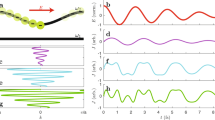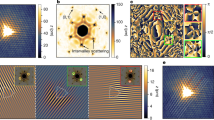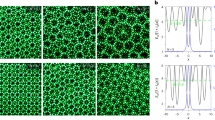Abstract
A central goal of condensed-matter physics is to understand how the diverse electronic and optical properties of crystalline materials emerge from the wavelike motion of electrons through periodically arranged atoms. However, more than 90 years after Bloch derived the functional forms of electronic waves in crystals1 (now known as Bloch wavefunctions), rapid scattering processes have so far prevented their direct experimental reconstruction. In high-order sideband generation2,3,4,5,6,7,8,9, electrons and holes generated in semiconductors by a near-infrared laser are accelerated to a high kinetic energy by a strong terahertz field, and recollide to emit near-infrared sidebands before they are scattered. Here we reconstruct the Bloch wavefunctions of two types of hole in gallium arsenide at wavelengths much longer than the spacing between atoms by experimentally measuring sideband polarizations and introducing an elegant theory that ties those polarizations to quantum interference between different recollision pathways. These Bloch wavefunctions are compactly visualized on the surface of a sphere. High-order sideband generation can, in principle, be observed from any direct-gap semiconductor or insulator. We thus expect that the method introduced here can be used to reconstruct low-energy Bloch wavefunctions in many of these materials, enabling important insights into the origin and engineering of the electronic and optical properties of condensed matter.
This is a preview of subscription content, access via your institution
Access options
Access Nature and 54 other Nature Portfolio journals
Get Nature+, our best-value online-access subscription
$29.99 / 30 days
cancel any time
Subscribe to this journal
Receive 51 print issues and online access
$199.00 per year
only $3.90 per issue
Buy this article
- Purchase on Springer Link
- Instant access to full article PDF
Prices may be subject to local taxes which are calculated during checkout




Similar content being viewed by others
Data availability
The datasets generated and/or analysed during the current study are available in the Materials Cloud repository36. Source data are provided with this paper.
Code availability
The codes used in the data analysis are available at Zenodo37.
References
Bloch, F. Über die quantenmechanik der elektronen in kristallgittern. Z. Phys. 52, 555–600 (1929).
Zaks, B., Liu, R. B. & Sherwin, M. S. Experimental observation of electron–hole recollisions. Nature 483, 580–583 (2012).
Banks, H. et al. Terahertz electron–hole recollisions in GaAs/AlGaAs quantum wells: robustness to scattering by optical phonons and thermal fluctuations. Phys. Rev. Lett. 111, 267402 (2013).
Zaks, B., Banks, H. & Sherwin, M. S. High-order sideband generation in bulk GaAs. Appl. Phys. Lett. 102, 012104 (2013).
Langer, F. et al. Lightwave-driven quasiparticle collisions on a subcycle timescale. Nature 533, 225–229 (2016).
Banks, H. B. et al. Dynamical birefringence: electron–hole recollisions as probes of Berry curvature. Phys. Rev. X 7, 041042 (2017).
Valovcin, D. C. et al. Optical frequency combs from high-order sideband generation. Opt. Express 26, 29807–29816 (2018).
Langer, F. et al. Lightwave valleytronics in a monolayer of tungsten diselenide. Nature 557, 76–80 (2018).
Borsch, M. et al. Super-resolution lightwave tomography of electronic bands in quantum materials. Science 370, 1204–1207 (2020).
Yang, H. F. et al. Visualizing electronic structures of quantum materials by angle-resolved photoemission spectroscopy. Nat. Rev. Mater. 3, 341–353 (2018).
Damascelli, A., Hussain, Z. & Shen, Z. X. Angle-resolved photoemission studies of the cuprate superconductors. Rev. Mod. Phys. 75, 473–541 (2003).
Lawaetz, P. Valence-band parameters in cubic semiconductors. Phys. Rev. B 4, 3460–3467 (1971).
Vurgaftman, I., Meyer, J. R. & Ram-Mohan, L. R. Band parameters for III–V compound semiconductors and their alloys. J. Appl. Phys. 89, 5815–5875 (2001).
Skolnick, M. S. et al. An investigation of anisotropy of valence band of GaAs by cyclotron-resonance. J. Phys. C 9, 2809–2821 (1976).
Itatani, J. et al. Tomographic imaging of molecular orbitals. Nature 432, 867–871 (2004).
Luftner, D. et al. Imaging the wave functions of adsorbed molecules. Proc. Natl Acad. Sci. USA 111, 605–610 (2014).
Shafir, D., Mairesse, Y., Villeneuve, D. M., Corkum, P. B. & Dudovich, N. Atomic wavefunctions probed through strong-field light-matter interaction. Nat. Phys. 5, 412–416 (2009).
Ghimire, S. & Reis, D. A. High-harmonic generation from solids. Nat. Phys. 15, 10–16 (2019).
Hohenleutner, M. et al. Real-time observation of interfering crystal electrons in high-harmonic generation. Nature 523, 572–575 (2015).
Ghimire, S. & Reis, D. A. High-harmonic generation from solids. Nat. Phys. 15, 10–16 (2019).
Liu, H. Z. et al. High-harmonic generation from an atomically thin semiconductor. Nat. Phys. 13, 262–265 (2017).
Vampa, G. et al. All-optical reconstruction of crystal band structure. Phys. Rev. Lett. 115, 193603 (2015).
Luu, T. T. et al. Extreme ultraviolet high-harmonic spectroscopy of solids. Nature 521, 498–502 (2015).
Ramian, G. The new UCSB free-electron lasers. Nucl. Instrum. Methods Phys. A 318, 225–229 (1992).
Luttinger, J. M. & Kohn, W. Motion of electrons and holes in perturbed periodic fields. Phys. Rev. 97, 869–883 (1955).
Bernevig, B. A., Hughes, T. L. & Zhang, S. C. Quantum spin Hall effect and topological phase transition in HgTe quantum wells. Science 314, 1757–1761 (2006).
Fulop, J. A., Tzortzakis, S. & Kampfrath, T. Laser-driven strong-field terahertz sources. Adv. Opt. Mater. 8, 1900681 (2020).
Yablonovitch, E., Hwang, D. M., Gmitter, T. J., Florez, L. T., Harbison, J. P. Van der Waals bonding of GaAs epitaxial liftoff films onto arbitrary substrates. Appl. Phys. Lett. 56, 2419–2421 (1990).
Cole, G. D. et al. High-performance near- and mid-infrared crystalline coatings. Optica 3, 647–656 (2016).
Yablonovitch, E., Gmitter, T., Harbison, J. P., Bhat, R. Extreme selectivity in the lift-off of epitaxial GaAs films. Appl. Phys. Lett. 51, 2222–2224 (1987).
Cole, G. D., Zhang, W., Martin, M. J., Ye, J., Aspelmeyer, M. Tenfold reduction of Brownian noise in high-reflectivity optical coatings. Nat. Photon. 7, 644–650 (2013).
Wilmer, B. L., Webber, D., Ashley, J. M., Hall, K. C., Bristow, A. D. Role of strain on the coherent properties of GaAs excitons and biexcitons. Phys. Rev. B 94, 075207 (2016).
Kaminski, J. P. et al. Far-infrared cavity dump coupling of the UC Santa Barbara free-electron laser. Appl. Phys. Lett. 57, 2770–2772 (1990).
Takahashi, S., Ramian, G., Sherwin, M. S. Cavity dumping of an injection-locked free-electron laser. Appl. Phys. Lett. 95, 234102 (2009).
Voon, L. C. L. Y. & Willatzen, M. The k·p Method: Electronic Properties of Semiconductors (Springer Science & Business Media, 2009).
Costello, J. B. et al. Reconstruction of Bloch wavefunctions of holes in a semiconductor. Materials Cloud Archive 2021.113 https://doi.org/10.24435/materialscloud:m0-t8 (2021).
Banks, H. B., Valovcin, D. C., O'Hara, S. D. & Costello, J. B. SherwinGroup/HSG-turbo: 2021 release. Zenodo https://doi.org/10.5281/zenodo.5116718 (2021).
Acknowledgements
We acknowledge R. B. Liu and M. Kira for reading an earlier version of the manuscript; G. Cole and P. Heu for assistance with GaAs membrane fabrication; A. Peñaloza for assistance with the design and fabrication of cryostat modifications; C. Cannon for implementing software for Monte Carlo error estimation; D. Enyeart and N. Agladze for assistance with maintaining and operating the UCSB millimetre-wave free-electron laser; and J. Meyer and I. Vurgaftman for a discussion. The portion of this research conducted at UCSB was funded by NSF-DMR 1710639 and NSF-DMR 2004995. Upgrades to the UCSB terahertz facility that was used for this research were funded by NSF-DMR 1626681 and NSF-DMR 1126894. The portion of this research conducted at Princeton was funded in part by the Gordon and Betty Moore Foundation’s EPiQS Initiative, Grant GBMF9615 to L.N.P., and by the National Science Foundation MRSEC grant DMR 1420541.
Author information
Authors and Affiliations
Contributions
Performing experiments, data collection and analysis: S.D.O. and J.B.C. Software: J.B.C., D.C.V. and S.D.O. Theory: Q.W. Conceptualization: M.S.S. and Q.W. Resources (GaAs epilayer growth): K.W.W. and L.N.P. Development of broad-band polarimetry: D.C.V. Writing: M.S.S., Q.W., S.D.O. and J.B.C. Supervision, funding acquisition and project administration: M.S.S.
Corresponding author
Ethics declarations
Competing interests
The authors declare no competing interests.
Additional information
Peer review information Nature thanks the anonymous reviewers for their contribution to the peer review of this work. Peer reviewer reports are available.
Publisher’s note Springer Nature remains neutral with regard to jurisdictional claims in published maps and institutional affiliations.
Extended data figures and tables
Extended Data Fig. 1 Field enhancement at the GaAs epilayer from the ITO-coated sapphire substrate.
The field enhancement is calculated as \(|1+r({f}_{{\rm{THz}}})|\) with the complex reflection coefficient \(r({f}_{{\rm{THz}}})\) measured by a Vector Network Analyzer.
Extended Data Fig. 2 An absorbance spectrum of the GaAs epilayer mounted on the ITO-coated sapphire substrate.
The measurement was taken at the spot illuminated by a white light source (left inset). The right inset shows a zoom-in of the spectrum, with the bandgap and the photon energy of the NIR laser denoted by dash-dot blue and red lines, respectively. The two peaks are strain-split exciton resonances associated with band-edge states with different angular momenta. The temperature was 60 K.
Extended Data Fig. 3 Stokes polarimetry with linearly polarized NIR laser (γNIR = 0°).
a, Polaragrams for sideband index \(n=12\) and orientation angle of the NIR laser \({\alpha }_{{\rm{NIR}}}=0^\circ \). b, The polarization state of the sideband extracted from the polaragrams in a. c, Polaragrams for sideband index \(n=24\) and orientation angle of the NIR laser \({\alpha }_{{\rm{NIR}}}=45^\circ \). d, The polarization state of the sideband extracted from the polaragrams in c. In a and c, the black dots show the measured polaragrams, with error bars showing the standard deviation over 4 measurements, and the red solid lines are the reconstructed polaragram through Fourier transform, with the red dotted lines showing the bounds. In b and d, the polarization states of the sidebands are represented as trajectories of the tips of the electric field vectors \(({E}_{x},{E}_{y})\) over time. The orientation angle \(\alpha \) and ellipticity angle \(\gamma \) are defined in the inset in b.
Extended Data Fig. 4 Quantum interference in three-step model of HSG leading to sideband polarization.
A photon from the NIR laser is decomposed into components \({\sigma }_{{\rm{NIR}}}^{\pm }\), with helicity ±1. a, A \({\sigma }_{{\rm{NIR}}}^{-}\) photon excites either a spin-up electron and hole of spin −3/2 or a spin-down electron and hole of spin −1/2. A \({\sigma }_{{\rm{NIR}}}^{+}\) photon excites either a spin-up electron and hole of spin +1/2 or a spin-down electron and hole of spin +3/2. b, Driven by the THz field, an electron-hole pair accumulates dynamic phase \({A}_{{HH}}\) or \({A}_{{LH}}\), depending on the band of the hole state (HH or LH). The electron spin is unchanged, while the hole states originating from the spin −3/2 state are superpositions of spin −3/2 and +1/2 states and the states originating from the spin −1/2 state are superpositions of spin −1/2 and +3/2 states. c, Upon recollision, either \({\sigma }_{{\rm{HSG}}}^{+}\) or \({\sigma }_{{\rm{HSG}}}^{-}\) photons are produced following angular momentum conservation—for example, a spin +3/2 hole recombining with a spin-down (−1/2) electron produces a \({\sigma }_{{\rm{HSG}}}^{+}\) photon with helicity +3/2 −1/2 = +1. The interference of the evolution pathways from \({\sigma }_{{\rm{NIR}}}^{\pm }\) to \({\sigma }_{{\rm{HSG}}}^{+}\) (\({\sigma }_{{\rm{HSG}}}^{-}\)) produces the dynamical Jones matrix element \({T}_{+\pm }\) \(({T}_{-\pm })\).
Extended Data Fig. 5 Additional data for ratios of Jones matrix elements, \({{\boldsymbol{\xi }}}_{{\boldsymbol{n}}}({\boldsymbol{\theta }})\) and \({{\boldsymbol{\chi }}}_{{\boldsymbol{n}}}({\boldsymbol{\theta }})\).
a, The argument of \({{\boldsymbol{\xi }}}_{{\boldsymbol{n}}}({\boldsymbol{\theta }})\). The dash-dot line marks the expected value of 0. b, The magnitude of \({{\boldsymbol{\xi }}}_{{\boldsymbol{n}}}({\boldsymbol{\theta }})\). The dash-dot line marks the expected value of 1. c, The magnitude of \({{\boldsymbol{\chi }}}_{{\boldsymbol{n}}}({\boldsymbol{\theta }})\). The dash-dot line marks the expected value of 1. All quantities are presented as functions of sideband index n for eight values of angle \({\boldsymbol{\theta }}\). Inset, The definition of \({\boldsymbol{\theta }}\) by using the GaAs crystal lattice and the THz electric field.
Extended Data Fig. 6 Monte Carlo simulation in calculating the dynamical Jones matrices.
a, The polarization state of the \(n=12\) sideband (\(\theta =23^\circ \)) for all 4 initial NIR polarizations (i-\({\alpha }_{{\rm{NIR}}}=0^\circ \), ii-\({\alpha }_{{\rm{NIR}}}=45^\circ \), iii- \({\alpha }_{{\rm{NIR}}}=90^\circ \), iv- \({\alpha }_{{\rm{NIR}}}=-45^\circ \)). The horizontal and vertical axes represent \(\alpha \) and \(\gamma \), respectively. Dashed ovals correspond to confidence intervals in the measurement of \(\alpha \) and \(\gamma \). b, Histograms of \(\alpha \) and \(\gamma \) for the 4 measured sidebands' polarizations. Normal distributions of \(\alpha \) and \(\gamma \) were sampled, with the central value and standard deviation of the distributions set by the measured values. In this figure, 1,000 iterations are shown, but the results of this paper are calculated from 10,000 iterations. c, The complex \({\mathscr{J}}\)-matrix elements resulting from the \(\alpha \) and \(\gamma \) in b. The horizontal and vertical axes represent the real and imaginary part, respectively. Each red dashed line shows one standard deviation of the distribution of each \({\mathscr{J}}\)-matrix element resulting from the Monte Carlo simulation. All three plots have the same scale. The value of \({{\mathscr{J}}}_{{xx},n}\) is set as 1 in these calculations.
Extended Data Fig. 7 Berry connection matrix element \(\,{\boldsymbol{\mathscr{A}}}_{H{H}_{+},H{H}_{+}}\) in the kz = 0 plane of the Brillouin zone.
The double-headed black dotted arrow represents a path of a hole accelerated by a linearly polarized THz field, which is perpendicular to the Berry connection (color arrows) at all points. The Berry connection is plotted in units of \(a\), which is the lattice constant of GaAs.
Extended Data Fig. 8 Effect of a biaxial strain on the valence band structure and non-Abelian Berry connection along the direction of quasi-momentum k in the kz = 0 plane of the Brillouin zone.
The strain is chosen as tensile along [001] direction to be consistent with the splitting of the exciton peaks in the absorbance spectrum (Extended Data Fig. 2). a, Valence band structures along \({k}_{x}={k}_{z}=0\) for unstrained (top) and strained (bottom) GaAs. The blue and orange curves represent the heavy-hole and light-hole bands, respectively. b, The magnitude of the diagonal Berry connection matrix element \({{\mathscr{A}}}_{H{H}_{+},H{H}_{+}}\) along the direction of quasi-momentum for unstrained (top) and strained (bottom) GaAs. c, The magnitude of the off-diagonal Berry connection matrix element \({{\mathscr{A}}}_{H{H}_{+},L{H}_{+}}\) along the direction of quasi-momentum for unstrained (top) and strained (bottom) GaAs. For the unstrained case, the Berry connection along the quasi-momentum is identically zero in the plots except for the singularity at \({\boldsymbol{k}}\)=0. The Berry connection is plotted in units of \(a\), which is the lattice constant of GaAs.
Supplementary information
Supplementary Information
This file contains Supplementary Methods, a Supplementary Discussion and Supplementary References.
Source data
Rights and permissions
About this article
Cite this article
Costello, J.B., O’Hara, S.D., Wu, Q. et al. Reconstruction of Bloch wavefunctions of holes in a semiconductor. Nature 599, 57–61 (2021). https://doi.org/10.1038/s41586-021-03940-2
Received:
Accepted:
Published:
Issue Date:
DOI: https://doi.org/10.1038/s41586-021-03940-2
This article is cited by
-
Lightwave electronics in condensed matter
Nature Reviews Materials (2023)
-
Gate-tunable quantum pathways of high harmonic generation in graphene
Nature Communications (2022)
-
Attosecond clocking of correlations between Bloch electrons
Nature (2022)
Comments
By submitting a comment you agree to abide by our Terms and Community Guidelines. If you find something abusive or that does not comply with our terms or guidelines please flag it as inappropriate.



